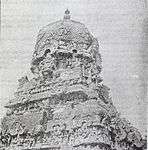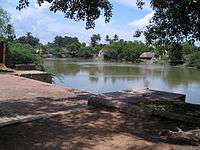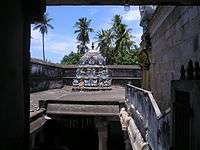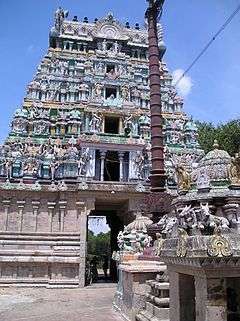Kalyanasundaresar Temple, Nallur
| Kalyanasundaresar Temple | |
|---|---|
|
View of the Kalyanasundaresar temple tower | |
 Kalyanasundaresar Temple Location in Tamil Nadu | |
| Name | |
| Proper name | Tirunallur Temple |
| Geography | |
| Coordinates | 10°55′N 79°19′E / 10.917°N 79.317°ECoordinates: 10°55′N 79°19′E / 10.917°N 79.317°E |
| Country | India |
| State/province | Tamil Nadu |
| District | Thanjavur |
| Locale | Nallur |
| Culture | |
| Primary deity | Kalyanasundaresar (Shiva) |
| Architecture | |
| Architectural styles | Dravidian architecture |
Kalyanasundaresar Temple or Thirunallur is a Hindu temple dedicated to the deity Shiva, located in Nallur, in the outskirts of Kumbakonam in Tamil Nadu, India. Shiva is worshiped as Kalyansundaresar, and is represented by the lingam. His consort Parvati is depicted as Girisundari. The presiding deity is revered in the 7th century Tamil Saiva canonical work, the Tevaram, written by Tamil saint poets known as the nayanars and classified as Paadal Petra Sthalam. The legend of the temple is associated with sage Agastya and Amaraneethi Nayanar, one of the 63 nayanars, the Tamil Saiva saints. The lingam in the temple is believed to change colours five times during the day time.
The temple complex has three precincts and houses two gateway towers known as gopurams. All the central shrines of the temple are located in an artificial hillock, while the shrine of Kali is located in the third precinct in the basement. The original masonry structure was built during the Chola dynasty in the 9th century, while later expansions are attributed to Vijayanagar rulers of the Sangama Dynasty (1336–1485 CE), the Saluva Dynasty and the Tuluva Dynasty (1491–1570 CE). The temple has six daily rituals at various times from 5:30 a.m. to 10 p.m., and twelve yearly festivals on its calendar. Devotees are blessed with Sadari, a practice followed only in Vishnu temples. The temple is maintained and administered by the Thiruvaduthurai Adheenam from the early 13th century.
Legend
According to the Hindu legend, Shiva sent sage Agastya to this place to balance the weight of gods attending his marriage with Paravathi. At the spot where the temple now stands, the sage Agastya witnessed the marriage of Shiva and Parvathi. The sage installed a lingam behind the main lingam in the temple to worship Shiva. As per another legend, one of the 63 nayanmars, Amaraneethi Nayanar, spent his life supplying undergarments to all worshipers of Shiva. Shiva wanted to test his devotion and appeared to him in the form of a Brahmin. The Brahmin deposited a piece of rag in the custody of Amaraneethi, which was lost by a trick. The Brahmin demanded equal weight of gold in return of the lost rag. Amaraneethi deposited all his wealth in one side of a scale pan, but it did not balance. Finally, he submitted himself and his wife in the scale pan. Shiva was pleased by the devotion of the nayanar and bestowed him with all his wishes.[1][2]
History

The 7th century Nayanar saints Sambandar and Appar wrote of the temple in their poetic work, Tevaram. The original masonry and towers date back to the 9th century CE, as seen from an inscription in the structure made by Chola kings. The Chola kings ruled over the region for more than four centuries, from 850 CE to 1280 CE, and were temple patrons. The temple complex dates from the time of the 10th century AD Medieval Chola king Uttama Chola whose inscriptions are found in its walls. An inscription dated to the fifteenth year of Raja Raja Chola makes a reference to "Panchavanmahadevi chaturvedimanagalam", which is another name for Nallur. There are also inscription by Later Chola kings and by Hoysala monarchs. The inscriptions from the Chola kings record various gifts like land, sheep, cow and oil to the temple commemorating various victories of the dynasty. There are lot of inscriptions from the Sangama Dynasty (1336–1485 CE), Saluva Dynasty, and Tuluva Dynasty (1491–1570 CE) of the Vijayanagara Empire, reflecting gifts to the temple from their rulers. The majority of the gift related inscriptions are for land endownments, followed by goods, cash endowments, cows and oil for lighting lamps.[1] The temple has been maintained by the Thiruvaduthurai Adheenam from the early part of the 13th century.[3][4]
The Temple
The temple is located 10 km (6.2 mi) away from Kumbakonam, 6 km (3.7 mi) east of Thirukkarugavur and 30 km (19 mi) south of Thanjavur. The temple has a five-tiered Rajagopuram (gateway tower). The main shrines of the temple are located in an artificial hillock. The images of the presiding deity, Kalyanasundaresar, in the form of lingam (iconic form of Shiva) in a pedestal, occupies the main sanctum. The second lingam, believed to be installed by sage Agastya is in the sanctum. The walls on the interior of the sanctum have sculptural representations of Shiva and Parvathi on the west, Vishnu on the north and Brahma on the south. The shrine of Girisundari Amman, the consort of Kalyanasundaresar, is located in the first precinct facing west. The temple also has a bronze image of Nataraja, the cosmic dance form of Shiva. Nataraja in the temple is depicted with eight hands and in a standing posture over the head of a demon. The image is considered to be one of the nine dance poses of Shiva, called Navathandavam. The temple has sculptural and metallic images of Ganapathi (elephant god), sage Agasthya and the three Saiva saints Appar, Sambandar and Sundarar. The temple also has an image of Somaskanda (a representation of Shiva with his consort Uma, and Skanda as a child), which is considered similar to the one present in the Thyagaraja temple in Thiruvarur. The third prakaram downstairs houses a separate shrine for the Hindu god Kali. The temple has a large tank called Sapthasagaram, located outside the main entrance. The temple complex is enclosed by granite walls, built around the third precinct.[1][2]
Worship and religious practises

The temple priests perform the puja (rituals) during festivals and on a daily basis. Like other Shiva temples of Tamil Nadu, the priests belong to the Shaiva community, a Brahmin sub-caste. The temple rituals are performed six times a day; Ushathkalam at 5:30 a.m., Kalasanthi at 8:00 a.m., Uchikalam at 10:00 a.m., Sayarakshai at 5:00 p.m., Irandamkalam at 7:00 p.m. and Ardha Jamam at 8:00 p.m. Each ritual comprises four steps: abhisheka (sacred bath), alangaram (decoration), naivethanam (food offering) and deepa aradanai (waving of lamps) for both Kalyanasundaresar and Girisundari. The worship is held amidst music with nagaswaram (pipe instrument) and tavil (percussion instrument), religious instructions in the Vedas (sacred texts) read by priests and prostration by worshippers in front of the temple mast. There are weekly rituals like somavaram (Monday) and sukravaram (Friday), fortnightly rituals like pradosham and monthly festivals like amavasai (new moon day), kiruthigai, pournami (full moon day) and sathurthi. Shivrathri in February–March and Margazhi Tiruvadhirai in December–January are the major yearly festivals celebrated in the temple. During Masi Magam festival, the Somaskanda Murthy is taken in procession around the temple. Pregnant women conduct bangle ceremony in the temple, praying to the central deity of the temple and Kali for smooth delivery. Tonsure ceremony for getting children shaved for the first time to promote proper growth is a very common worship practice. Shiva is believed to have shown his feet to saint Thirunavukkarasar and hence the practice of blessing with Sadari, which is otherwise practiced in Vishnu temples, is followed in the temple.[2]
Religious significance

Tirugnana Sambandar, a 7th-century Tamil Saivite poet, venerated Kalyanasundaresar in eleven verses in Tevaram, compiled as the Second Tirumurai.[5] Appar, a contemporary of Sambandar, also venerated Kalyanasundaresar in ten verses in Tevaram, compiled as the Sixth Tirumurai.[6] As the temple is revered in Tevaram, it is classified as Paadal Petra Sthalam, one of the 276 temples that find mention in the Saiva canon. The temple is counted as the 20th temple on the southern bank of Cauvery that are recorded in the canon.
Tamil |
IPA |
you have a holy body in which a lady stays. | |
The temple tank, Sapthasagaram, is considered sacred. Kunti, the mother of Pandavas from the Mahabaratha period is believed to have taken a holy dip in the tank, worshiping Kalyanasundaresar. This incident is recorded in some of the inscriptions in the temple. The lingam in the temple is believed to change colours five times during the day time. From 6:00-8:24 a.m, it takes the colour of copper, light red from 8:25-10:48, molten gold from 10:49-15:12, unknown colour from 13:13-15:36 and emerald green from 15:37-18:00. The vilwa tree in the temple is believed to be the first of its kind in the planet and hence called "Aadhi tree". Gananatha, a form of Shiva, in the form of balipeeta (platform for offering), is located in the temple. It is the only other place outside Varanasi, where Gananatha is found in the form.[1][2]
References
- 1 2 3 4 P. V. Jagadisa Ayyar (1920). South Indian shrines: illustrated. Madras Times Printing and Pub. Co. pp. 360–369.
- 1 2 3 4 "Sri Kalyanasundaresar temple". Dinamalar. Retrieved 2013-07-04.
- ↑ "List of Padalpetra stalam maintained by Thiruvaduthurai Adheenam". Thiruvaduthurai Adheenam. Retrieved 2013-07-04.
- ↑ "History of Thiruvaduthurai Adheenam". Thiruvaduthurai Adheenam. Retrieved 2013-07-04.
- 1 2 Thirugnanasambandar (2004). Irandam Thirumurai (PDF). Online: Project Madurai. pp. 81–82. Retrieved 2013-07-04.
- ↑ Thirunavukkarasar (2004). Aaram Thirumurai (PDF). Online: Project Madurai. pp. 33–35. Retrieved 2013-07-04.
- ↑ "Irandam Thirumurai Translation". Thevaaram.org. 2012. Retrieved 2013-07-04.


